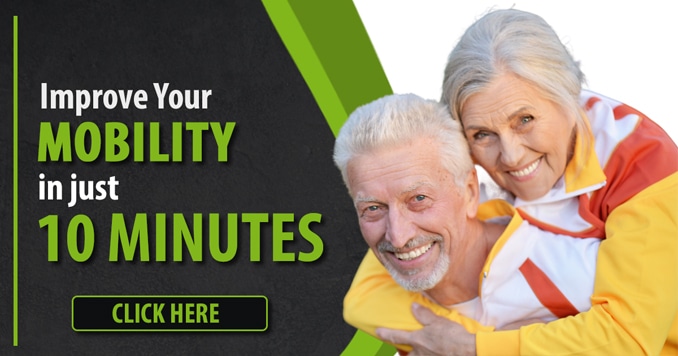Ready to reach your full potential? Let's boost your strength and movement to perform your best. Whether you're an athlete or just want to get fitter, this guide is for you.
We'll cover exercises, and mindset tricks to help you improve your strength and mobility. Because, “Strength and mobility are keys to conquering everyday challenges”.
What Does Strength and Mobility Mean?
Strength means how strong your muscles are for doing things like lifting or pushing. Having strong muscles helps you avoid falling, which can cause broken bones and other injuries.
While losing bone has been seen as normal with age, there's more attention now on sarcopenia, which is when muscles get weaker as you get older. Mobility is about how easily your body can move and bend. Mobility training works on making both your upper and lower body more flexible and able to move better.
How Does Mobility Training Improve Strength?
Mobility training boosts strength by making muscles and joints more flexible. With better mobility, muscles can move fully, engaging better.
This flexibility helps in doing strength exercises correctly, which recruits muscles better. Also, improved joint mobility makes you more stable, lowering injury risk.
Better flexibility and stability mean muscles work well, leading to stronger muscles over time. Mobility training lays the groundwork for stronger muscles, improving overall strength.
Proven Approaches to Boosting Flexibility
1. Targeted Exercises
To improve, do exercises that target the parts you want to work on. To get stronger, try moves that work many muscles, like squats and bench presses. These make you stronger. For flexibility, do stretches for the joints and muscles you want to loosen up. Like hip or shoulder stretches, or twisting your spine.
2. Taking Breaks
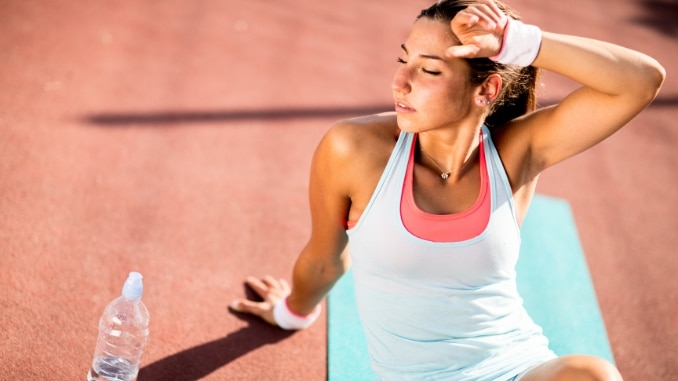
It's important to let your body rest to get stronger and more flexible. Take breaks from tough workouts so your muscles can heal and get stronger. Also, make sure to sleep enough(1)—it helps your muscles recover and makes you perform better overall.
3. Eating Right
As people age(2), they gradually lose muscle mass and strength, making daily tasks harder and increasing the risk of health issues. This muscle loss results from imbalances in how the body handles muscle proteins. Eating well is crucial for strength and flexibility. Ensure enough protein for muscle growth and recovery, and eat fruits, veggies, and whole grains for essential nutrients. Hydrate well to maintain healthy, flexible joints.
Get Fit and Flexible: 4 Must-Try Exercises for Strength and Mobility
Warm-up Exercise
1. Shoulder Mobility
- Begin in a 4-point position with your hands beneath your shoulders and your knees under your hips.
- Contract your abdominal area. Slowly arch your back as you squeeze your shoulder blades together.
- Relax and return to the starting position. Repeat the movement. Complete 3 repetitions.

Mobility Exercises
1. Knee Pushups to Child’s Pose
- Begin in a 4-point position with your hands beneath your shoulders and your knees under your hips.
- Move your knee backward to increase the angle of your body.
- Tighten your abdominal muscles and bend both your right elbow and left elbow to lower your upper body towards the floor, keeping your elbows tight to the side.
- Then, push from your hands to shift your hips back to your feet, moving into the Child’s Pose position.
- Lower your forehead to the floor, relaxing your mid-back area for a light stretch.
- Hold the position for several deep belly breaths, in through your nose and out through your mouth.
Return to the starting position and repeat the sequence of movement. Complete 5 repetitions.


 2. Full pushups with Downward-Facing Dog
2. Full pushups with Downward-Facing Dog
- Begin in a straight-arm plank position, maintaining good alignment with your head, shoulders, hips, and toes.
- Tighten your abdominal muscles. Bend your arms to lower your upper body down toward the floor, then straighten your arms to complete a pushup.
- Then, lift your hips towards the ceiling to form an inverted V-shape. Press your heels down towards the floor to stretch the calves.
- Hold this position for several deep belly breaths, in through your nose and out through your mouth.
- Return to the starting position and repeat the sequence of movement. Complete the movement for 3 sets in 5 repetitions.
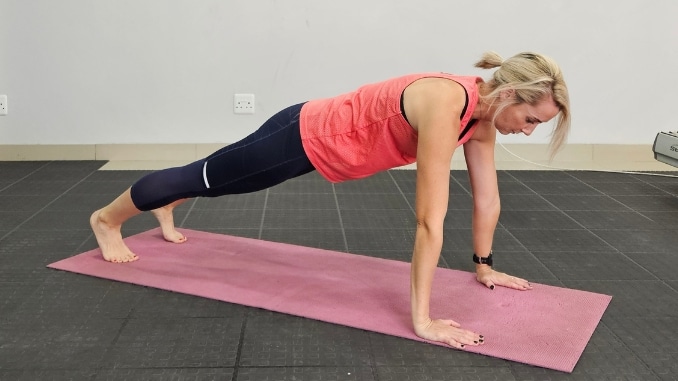


3. Side Plank
- Begin in a side plank position with your one leg on a kneeling position, maintaining good alignment with your head, shoulder, and hips.
- Anchor your left elbow on the floor for support while you place your opposite hand on your hip.
- Tighten your abdominal muscles and lift your right leg as you raise your right hand overhead; make sure your leg is parallel to your shoulder.
- Hold the position for several deep belly breaths, in through your nose and out through your mouth. Relax and repeat the movement on the opposite side.
 |
 |
Variation– Straight Arm Side Plank
Move into a side plank position with your hands on the floor supporting your body, and your leg is on a kneeling position. Place the other hand on the hip. Maintain good alignment with your head, shoulders, and hips. Tighten your core and hold this position for several deep belly breaths, in through your nose and out through your mouth. After that, relax and return to the starting position. Complete the movement for 3 sets in 5 repetitions.
To intensify this exercise, you can lift one leg and feel the stretch of your leg.

To intensify this exercise, you can lift one leg and extend, feeling the stretch of your body.
4. Push Ups on Stability Ball
For this exercise, utilize the use of a stability ball for support and balance.
Begin in a straight arm plank position, place your legs on top of the stability ball, and maintain good alignment with your head, shoulders, hips, and legs. Engage your core and slowly bend your arms to lower your upper body towards the floor. Return to the starting position and repeat to complete the push-up movement. Repeat the movement in 5 repetitions of 3 sets.
 |
 |
5 Best Common Mobility Exercises
1. Plank
Move into a full plank position, maintaining proper alignment with your head, shoulders, hips, and toes. Hold this position for 30 seconds to a minute. Take several deep belly breaths, in through your nose and out through your mouth. Relax and return to the starting position. Repeat the movement.

2. Deep Squat
Begin in an upright standing position with your feet slightly wider than hip-width apart and your toes pointing slightly outward. Maintain good alignment with your head, shoulders, and hips. Place your arms on the side. Engage your core and hinge from your hips to lower your upper body into a deep squat position. Keep your knees behind your toes, and do not let your knees fall inward. Hold this position for several deep belly breaths, in through your nose and out through your mouth. Press from your heels to return to the starting position and repeat the movement.
 |
 |
3. Shoulder Rolls
Begin in an upright standing position, maintaining good alignment with your head, shoulders, hips and legs. Place your arms on your side. Engage your core. Shift your shoulders forward, then roll them up and back until you feel resistance in your shoulder blades. Relax and repeat the movement.
 |
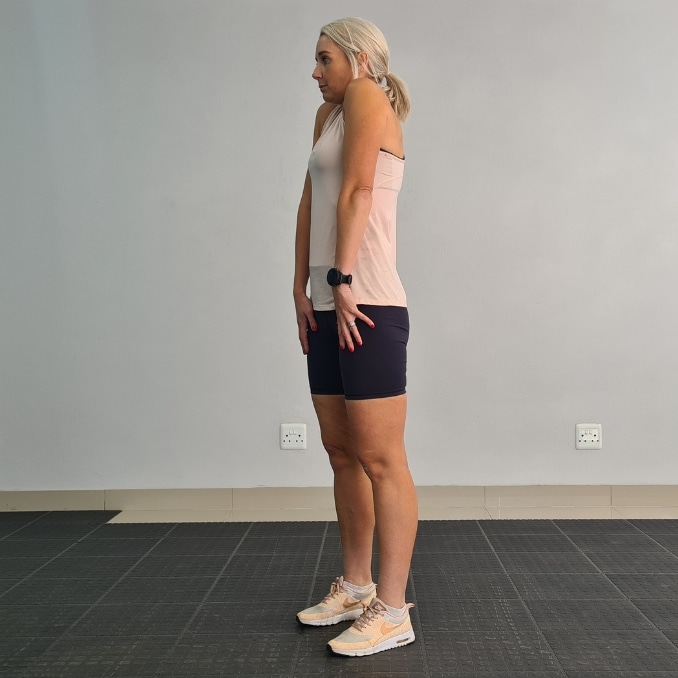 |
 |
4. Bent Knee Calf Raises
For this exercise, you can use the wall or the back of the chair for support if needed, as well as a plyometric box.
Begin in an upright standing position at the back of a chair with your feet hip-width apart, maintaining good alignment in your upper body. Step on the box with your toes and heel hanging. Place both hands on the back of the chair for support. Engage your core and bend the knees slightly, then raise your toes on both feet to lift your heels upward. Hold this position for a couple of seconds. Lower your heels to the starting position and repeat the movement.
 |
 |
5. Neck Roll
For this exercise, utilize the use of a tennis ball or a massage ball.
Begin in an upright standing position with your feet hip-width apart, maintaining good alignment of your head, shoulder, hips, and legs. Place your hands behind your head together with the massage ball. Engage your core and start by slowly tilting your head forward and gently rolling it in a counterclockwise direction. Return to the starting position and repeat the movement in a clockwise direction.
 |
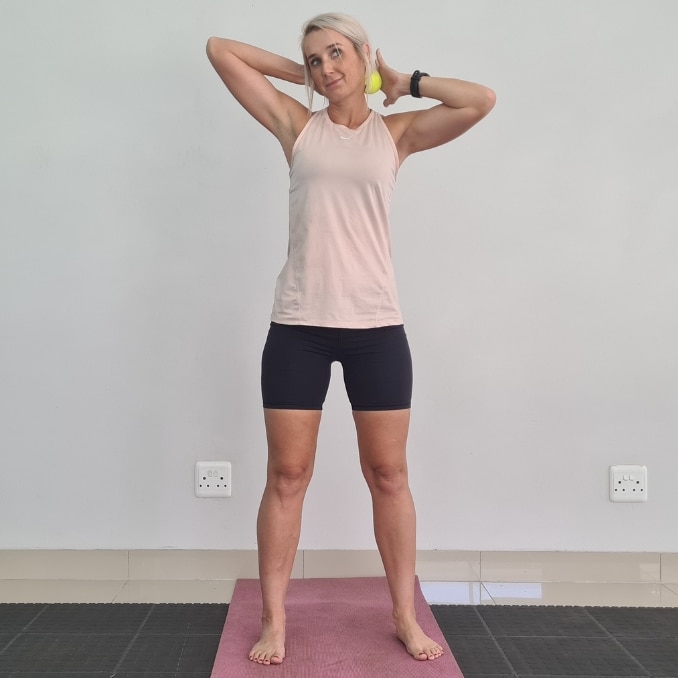 |
Note: Ensure smooth and controlled movements to avoid strain.
Benefits of Improving Strength and Mobility
A study in “Gerontology” (2013) by Urs Granacher and his team found that core stability exercises(3) can boost muscle strength, spine flexibility, balance, and mobility in older adults. In nine weeks, those who did these exercises showed big improvements in muscle strength(4), spine flexibility, walking speed, and balance. These findings suggest that these exercises could be a great way for older adults to stay strong and move well, possibly even better than traditional programs for seniors.
Here are key advantages that underscore the importance of focusing on these aspects:
1. Injury Prevention
Prioritizing strength exercises and mobility work aids in fortifying muscle fibers, increasing joint stability, and mitigating muscle imbalances. This comprehensive approach significantly reduces the risk of injuries, allowing you to meet the demands of physical activity without straining or risking harm.
2. Enhanced Everyday Functionality
Bolstering your entire body with a combination of strength and mobility training translates to improved functionality in daily life. From lifting heavy objects to executing basic tasks such as bending or reaching, a strong and mobile body enables seamless movement, diminishing the likelihood of strain or discomfort.
3. Reduced Muscle Stiffness
Regular mobility exercises alleviate muscle stiffness, especially after prolonged periods of inactivity. This contributes to overall comfort and ease of movement throughout the day.
4. Better Posture

Mobility training helps correct postural issues by addressing tight muscles and promoting a balanced musculoskeletal system. Improved posture leads to reduced stress on the spine and enhanced overall body alignment.
5. Joint Health
By encouraging proper movement in the joints, mobility training supports joint health and reduces the risk of degenerative conditions. It aids in maintaining the integrity of cartilage and synovial fluid.
6. Increased Body Awareness
Mobility exercises require focused attention on movement patterns, fostering a greater awareness of how your body moves. This heightened awareness can lead to improved coordination and mindful movement.
7. Longevity and Quality of Life
As we get older, we naturally become weaker and less mobile, but we can do things to slow this down. Doing strength exercises, moving around a lot, and working on staying flexible can help with this. It keeps our bodies strong and lets us keep doing the things we like for longer, helping us stay independent and active.
Conclusion
Getting stronger and moving better takes time, effort, and looking at everything together. By doing specific exercises, using good methods, eating well, and resting right, you can make your body perform its best.
People around the world are living increasingly sedentary lifestyles, yet the health risks associated with being inactive are plentiful, including obesity, heart disease, high blood pressure, high cholesterol, stroke, and diabetes. The Get Moving – 10 Minutes to Greater Mobility program is truly the best way to get started on your journey to better health! Check out now!



